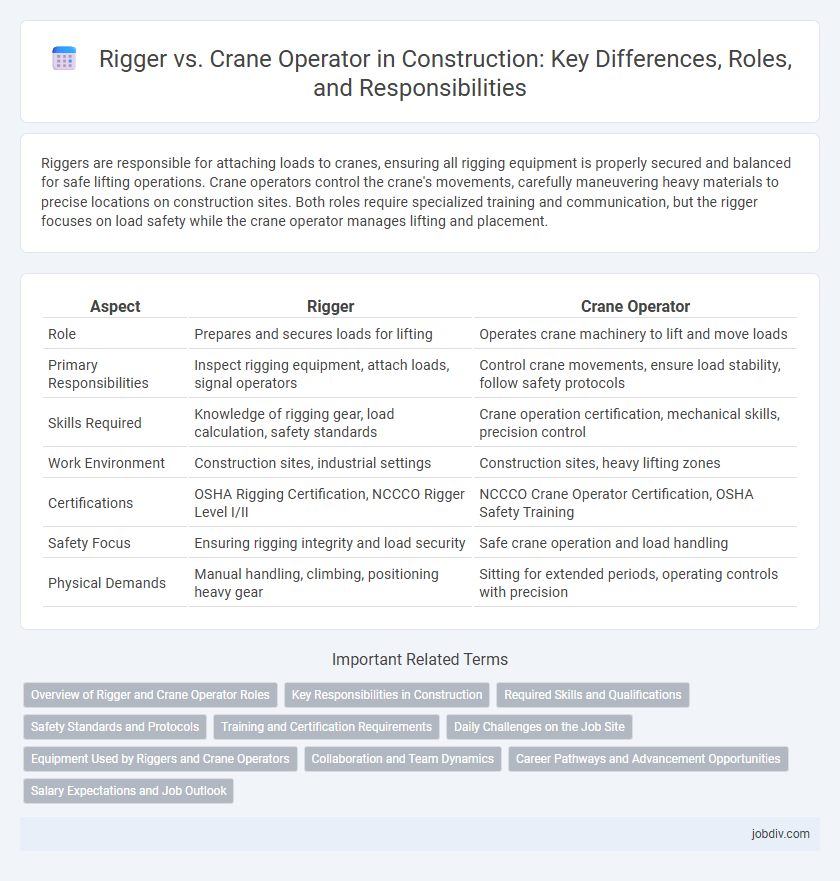Riggers are responsible for attaching loads to cranes, ensuring all rigging equipment is properly secured and balanced for safe lifting operations. Crane operators control the crane's movements, carefully maneuvering heavy materials to precise locations on construction sites. Both roles require specialized training and communication, but the rigger focuses on load safety while the crane operator manages lifting and placement.
Table of Comparison
| Aspect | Rigger | Crane Operator |
|---|---|---|
| Role | Prepares and secures loads for lifting | Operates crane machinery to lift and move loads |
| Primary Responsibilities | Inspect rigging equipment, attach loads, signal operators | Control crane movements, ensure load stability, follow safety protocols |
| Skills Required | Knowledge of rigging gear, load calculation, safety standards | Crane operation certification, mechanical skills, precision control |
| Work Environment | Construction sites, industrial settings | Construction sites, heavy lifting zones |
| Certifications | OSHA Rigging Certification, NCCCO Rigger Level I/II | NCCCO Crane Operator Certification, OSHA Safety Training |
| Safety Focus | Ensuring rigging integrity and load security | Safe crane operation and load handling |
| Physical Demands | Manual handling, climbing, positioning heavy gear | Sitting for extended periods, operating controls with precision |
Overview of Rigger and Crane Operator Roles
Riggers coordinate and secure loads for lifting, ensuring safety and stability during hoisting operations by attaching cables, chains, and slings. Crane operators control the crane's movements, managing the lifting, lowering, and precise placement of heavy materials on construction sites. Both roles require specialized training and certification to comply with OSHA regulations and maintain workplace safety standards.
Key Responsibilities in Construction
Riggers are responsible for securing loads, selecting rigging equipment, and ensuring safe load movement, critical for preventing accidents on-site. Crane operators manage crane operations, control equipment movements, and perform pre-operation inspections, ensuring precise lifting and placement of materials. Both roles require strict adherence to safety protocols to maintain workplace safety and project efficiency.
Required Skills and Qualifications
Riggers must possess in-depth knowledge of load dynamics, signaling protocols, and safety regulations, often requiring certification in rigging and extensive hands-on experience with slings, chains, and hoists. Crane operators need specialized training in operating various crane types, including mobile and tower cranes, with a strong emphasis on mechanical aptitude, precision control, and adherence to OSHA standards. Both roles demand physical fitness, spatial awareness, and the ability to interpret complex load charts and site plans to ensure safe and efficient lifting operations.
Safety Standards and Protocols
Riggers and crane operators must adhere to strict safety standards established by OSHA and ANSI to prevent accidents on construction sites. Riggers are responsible for inspecting load-bearing equipment, ensuring proper rigging techniques, and maintaining clear communication with crane operators to safely lift and maneuver heavy materials. Crane operators must have certification from accredited programs, perform pre-operation inspections, and follow load charts precisely to avoid tipping hazards and mechanical failures.
Training and Certification Requirements
Riggers must complete OSHA-approved training programs covering load securing, signaling, and hazard recognition, often earning certifications like NCCCO Rigger Level I or II. Crane operators require specialized certification from bodies such as the National Commission for the Certification of Crane Operators (NCCCO), demonstrating proficiency in crane types, safety protocols, and operational skills. Both roles demand rigorous training to ensure workplace safety and compliance with federal regulations, but crane operators typically undergo more extensive technical instruction compared to riggers.
Daily Challenges on the Job Site
Riggers face daily challenges involving securing heavy loads safely, ensuring precise communication with crane operators, and adapting to unpredictable site conditions like weather or ground stability. Crane operators manage complex controls to maneuver massive equipment with accuracy, maintain constant vigilance for nearby hazards, and adjust operations to comply with evolving site regulations and safety protocols. Both roles demand acute coordination and situational awareness to prevent accidents and maintain efficient workflow under high pressure.
Equipment Used by Riggers and Crane Operators
Riggers primarily use slings, shackles, hooks, and lifting chains to secure loads, ensuring safe attachment to cranes or other lifting devices. Crane operators control heavy machinery such as mobile cranes, tower cranes, and overhead cranes, utilizing complex controls to maneuver large objects precisely. Both roles require specialized equipment, but riggers handle the preparation and rigging tools, while crane operators focus on the machinery for lifting and moving materials on construction sites.
Collaboration and Team Dynamics
Riggers and crane operators must maintain precise communication to ensure safe and efficient lifts on construction sites. The rigger is responsible for selecting and securing loads, while the crane operator controls the crane's movements based on the rigger's signals. Strong collaboration and mutual trust between both roles are critical to prevent accidents and optimize workflow during hoisting operations.
Career Pathways and Advancement Opportunities
Riggers typically begin their careers as apprentices, gaining hands-on experience in securing loads and understanding rigging equipment, which can lead to advanced roles such as lead rigger or rigging supervisor. Crane operators often start with certification and extensive training on specific crane types, progressing to specialized operator positions or crane maintenance roles as they accumulate hours and skills. Both career paths offer advancement potential into supervisory or safety management roles within the construction industry, with strong demand for experienced professionals driving opportunities.
Salary Expectations and Job Outlook
Riggers typically earn an average annual salary ranging from $40,000 to $65,000, while crane operators command higher wages averaging $60,000 to $90,000 per year due to specialized training and certification requirements. The job outlook for crane operators is projected to grow by 6% over the next decade, driven by increased construction activity and infrastructure projects, whereas riggers face steady demand with a growth rate of about 4%. Both roles require rigorous safety adherence, but crane operators benefit from stronger salary growth potential tied to industry expansion and technological advancements in heavy equipment.
Rigger vs Crane Operator Infographic

 jobdiv.com
jobdiv.com